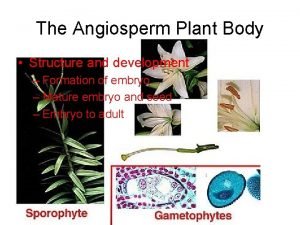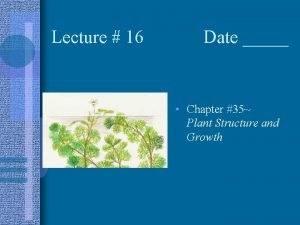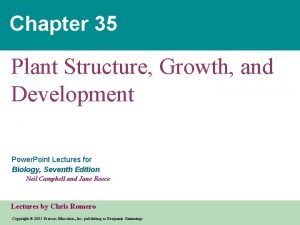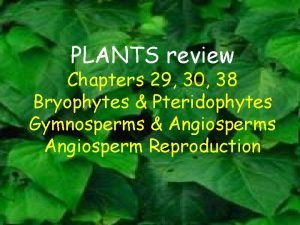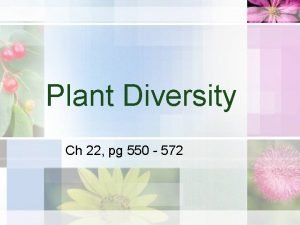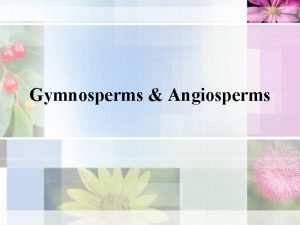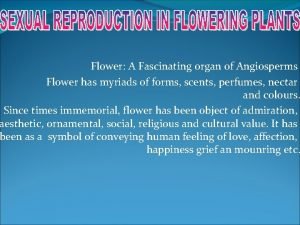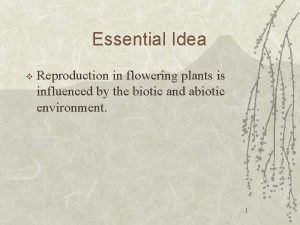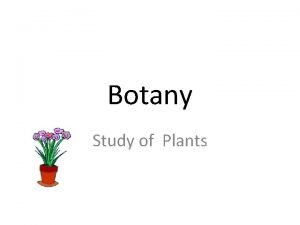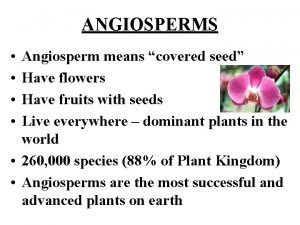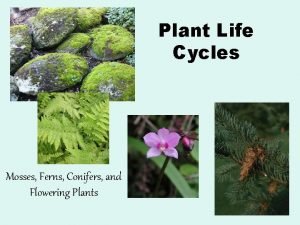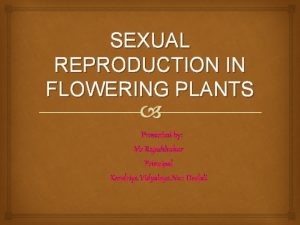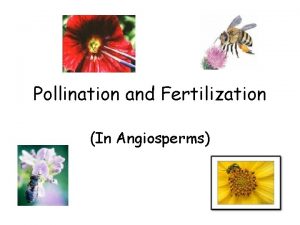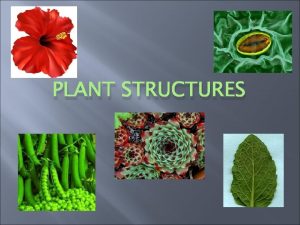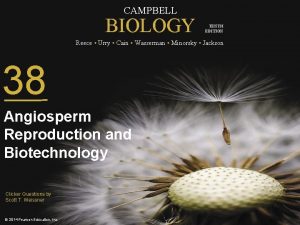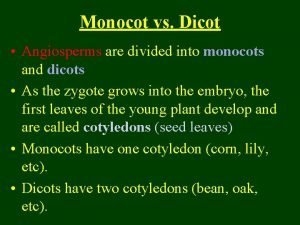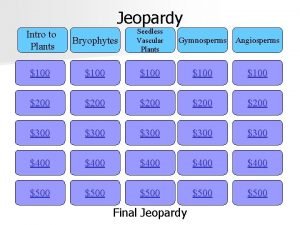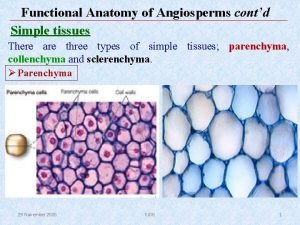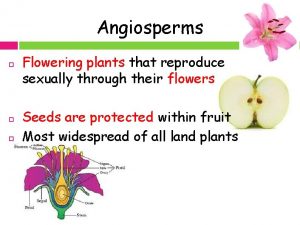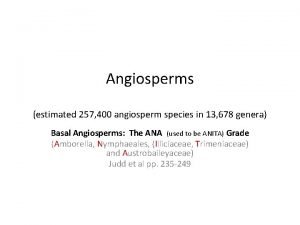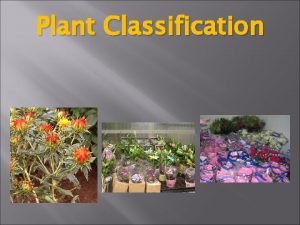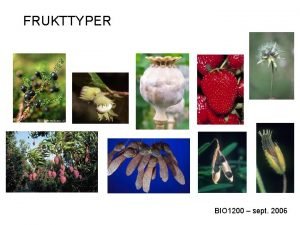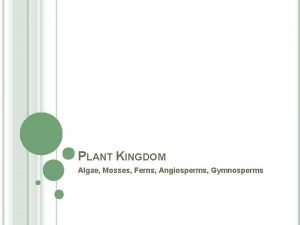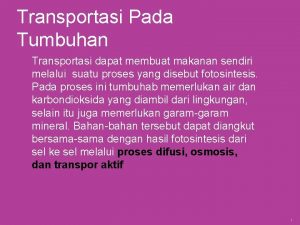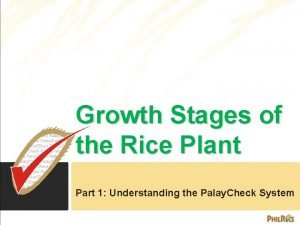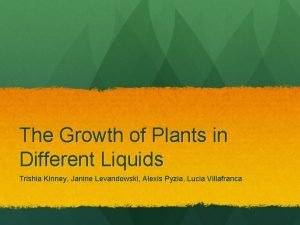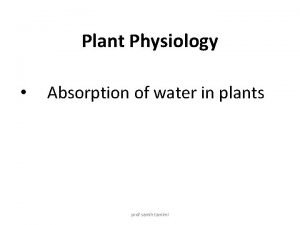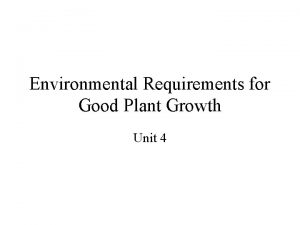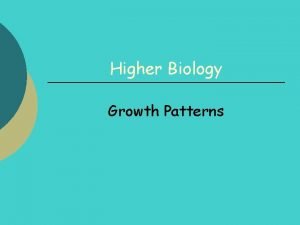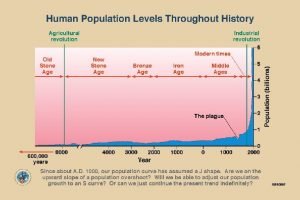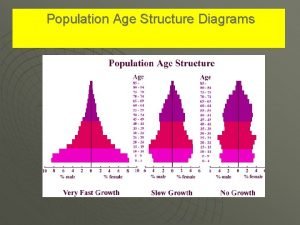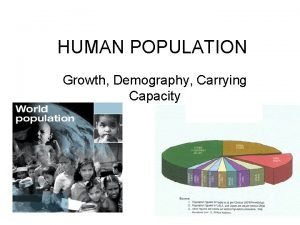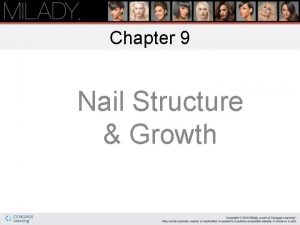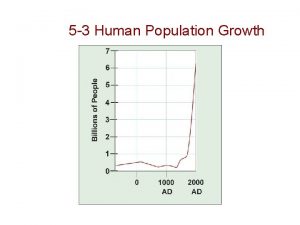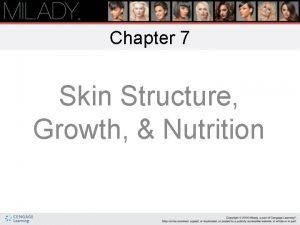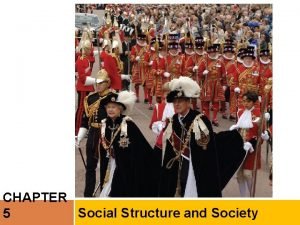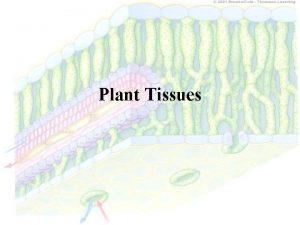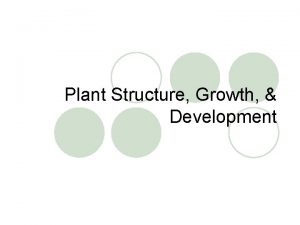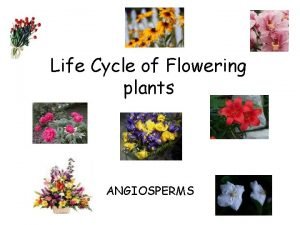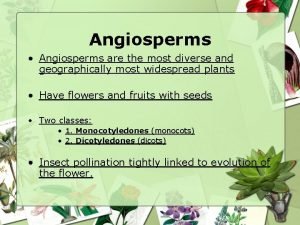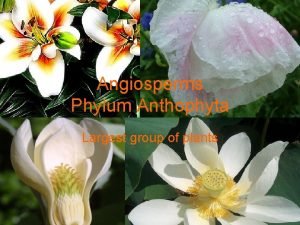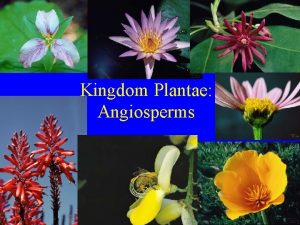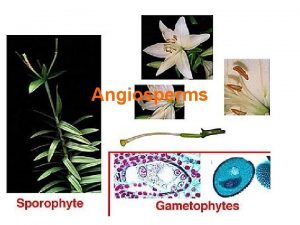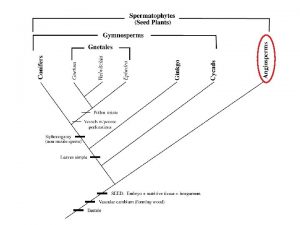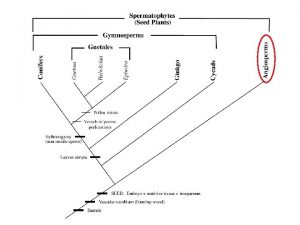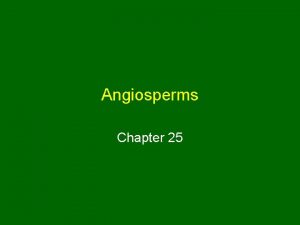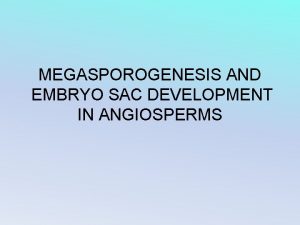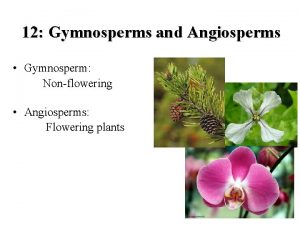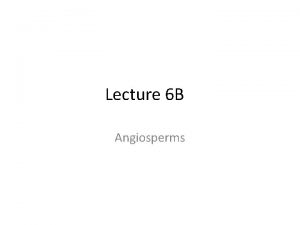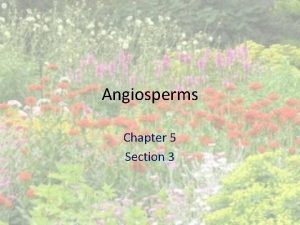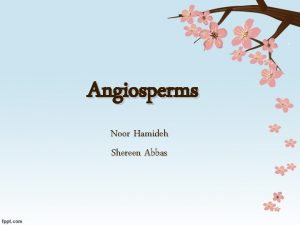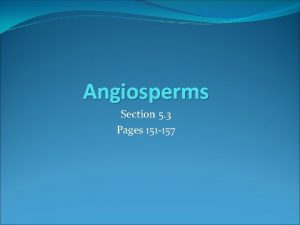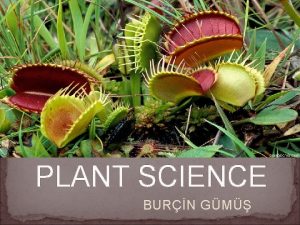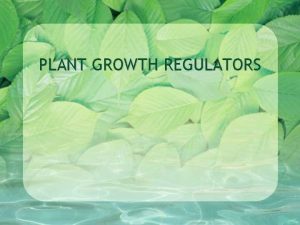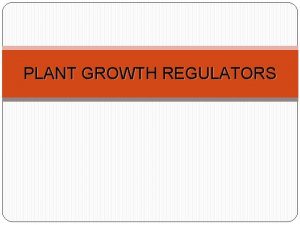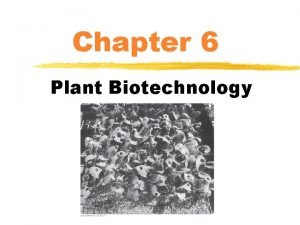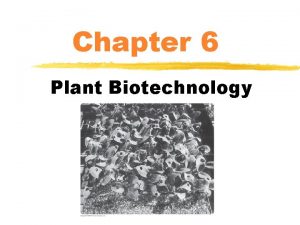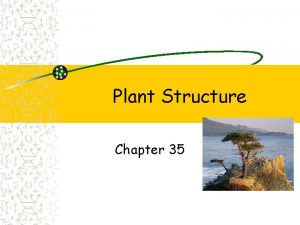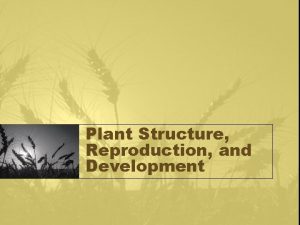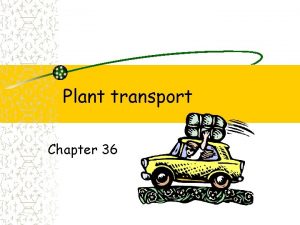Plant Science Plant Structure Growth Transport in Angiosperms

































































- Slides: 65

Plant Science Plant Structure & Growth Transport in Angiosperms Reproduction in Angiosperms author unknown address unknown accessed unknown

Plant Structure A. Monocots & Dicots B. Roots, Stems, & Leaves C. The Leaf D. Structural Adaptations E. Plant Growth author unknown address unknown accessed unknown

A. Monocots & Dicots 1. Angiospermophytes, or flowering plants are the most successful of all the plants 2. They are divides into two classes a. monocotyledons (monocots) b. dicotyledons (dicots)_ Wojtek Gil Photography http: //woyteg. com/blackberry/wallpapers/ accessed 05. 09. 07

3. Moncots differ from dicots in a number of distinct characteristics a. parallel versus net-like venation in leaves b. distribution of vascular tissue_ Biology Class Notes http: //sps. k 12. ar. us/massengale/plant_structure_bi 1. htm accessed 05. 09. 07 Biology Class Notes http: //sps. k 12. ar. us/massengale/plant_structure_bi 1. htm accessed 5. 09. 07 Click

c. number of cotyledons_ Beloit College http: //beloit. edu/~grossman/Botany/resources. htm accessed 05. 09. 07

d. floral organs in multiples of 3 in monocotyledonous versus 4 or 5 in dicotyledonous_ Wiki Books http: //en. wikibooks. org/wiki/Botany/Print_versio accessed 05. 09. 07 Bridgewater College http: //www. bridgewater. edu/~lhill/Monocotordicot. ht accessed 05. 09. 07 Click

e. unbranched roots in monocotyledonous versus branched roots in dicotyledonous_ Plants in the Hawaiin Environment http: //hawaii. edu/laurab/generalbotany/130 syllabus. htm accessed 28. 07

B. Roots Stems & Leaves 1. External parts of a dicotyledonous plant include a. root, stem, leaf b. axillary and terminal buds_ author unknown address unknown accessed unknown

2. The distribution of tissues in the stem, root and leaf of a generalized dicotyledonous plant can be seen in a plan diagram or “low-power” diagram a. plan diagrams show distribution of tissues (eg xylem, phloem) and do not show individual cells_ author unknown address unknown accessed unknown Think

C. The Leaf 1. There is a relationship between the distribution of tissues in the leaf and the functions of these tissues including a. absorption of light b. gas exchange c. support d. water conservation e. transport of water author unknown address unknown accessed unknown f. transport of products of photosynthesis_ author unknown address unknown accessed unknown Click

2 Epidermal Tissue a. water conservation (upper epidermis) secrete a waxy coating (cuticle) to minimize water loss_ author unknown address unknown accessed unknown Click

b. water conservation (lower epidermis) guard cells close stomata to minimize water loss_

3. Ground Tissue a. absorption of light (palisade layer) cells packed close together near the surface_ author unknown address unknown accessed unknown

b. gas exchange (spongy mesophyll) round, loosely arranged cells with air spaces between them_ author unknown address unknown accessed unknown

c. support & structure (collenchyma and sclerenchyma) common around the vascular bundles (of the midrib) and leaf tips_ author unknown address unknown accessed unknown

4. Vascular Tissue a. transport of water (xylem) brings water and mineral salts to the leaf b. transfer of products of photosynthesis (phloem) brings sucrose and other products away from the leaf_ author unknown address unknown accessed unknown Think

D. Structural Adaptations 1. Structural modifications can be made to roots, stems, and leaves to provide a variety of different functions a. storage roots (carrot) become swollen with food_ Biology Reerence http: //www. biologyreference. com/Re-Se/Roots. html accessed 30. 08. 07

b. stem tubers (potato) form on sections of stems that grow down into the soil and store food_ Allergy Resources International http: //allergyadvisor. com/Educational/Oct 05. htm accessed 31. 08. 07

c. bulbs (onion) form from the base of leaves growing under ground and store food_ About. com http: //gardening. about. com/od/gardeningwithkids/ig/Vegetable-Gardening-with-Kids/Egyptian-Walking-Onion. htm accessed 05. 09. 07

d. tendrils (sweet pea) are outgrowths of leaves that allow plants to attach to supports and climb upwards_ Canalphotos. org http: //canalphotos. org/photopage_303. htm accessed 05. 09. 07

E. Plant Growth 1. Dicotyledonous plants have apical and lateral meristems (regions that generate new cells for growth of the plant) a. apical meristems are sometimes referred to as primary meristems b. lateral meristems as cambium_ Custom Flute Shop http: //www. customflutes. com/poem. htm accessed 11. 09. 07

2. Compare growth due to apical and lateral meristems in dicotyledonous plants_ University of Florida http: //www. agen. ufl. edu/~chyn/age 2062/lect_15/lect_15. htm accessed 12. 09. 07 Web site เพอการเรยนการสอนชววทยาของเซลล http: //student. nu. ac. th/u 46410288/PLANT. HTM accessed 11. 09. 07 Click

3. Apical meristems a. located at the tips of roots and shoots b. supply cells for the plant to increase in length (grow up for shoots and down for roots) c. growth in this direction is known as primary growth_ Web site เพอการเรยนการสอนชววทยาของเซลล http: //student. nu. ac. th/u 46410288/PLANT. HTM accessed 11. 09. 07

4. Lateral meristems a. located near the periphery of the plant, usually in the vascular tissue b. supply cells for the plant to increase in girth c. growth in this direction is known as secondary growth d. annual rings are a way to visualize the work of lateral meristems_ Encyclopedia Britannica http: //www. britannica. com/eb/art-66141/Cross-section-of-a-tree-trunk accessed 12. 09. 07

5. Hormones control the growth of both stems and roots of plants a. stimulated by light and gravity (tropisms) 6. Auxin is the hormone responsible for phototropism, controlling plant growth toward light a. absorption of light by phototropins triggers the control of certain growth related genes_ University of Arkansas at Little Rock http: //www. ualr. edu/botany/botimages. html accessed 12. 09. 07 Planet Natural http: //www. planetnatural. com/site/photo_19. html accessed 12. 09. 07 Click

7. Auxin promotes elongation of cells in stems (loosening the connections between cellulose microfibrils in the cell wall) a. produced in the tips of growing stems and is transported down the stem b. transported laterally from the side with brighter light to the more shaded side_ Universiteit Maastricht http: //popgen. unimaas. nl/~jlindsey/commanster/Habitat/spruce. html accessed 12. 09. 07

c. higher concentration of auxin on shady side causes stem growth on this side d. stem grows curved toward light e. leaves attach to the sun receive more light (rate of photosynthesis increases)_ University of Wisconsin Madison http: //botit. botany. wisc. edu/images/130/Tropisms/gravitropism/+_gravitropism_MC_. html accessed 12. 09. 07

The End

Transport in Angiosperms A. Transpiration B. Abiotic Factors C. Regulating Transpiration D. Active Translocation E. Support Systems F. Mineral Absorption author unknown address unknown accessed unknown

A. Transpiration 1. Transpiration is the loss of water vapour from the leaves and stems of plants 2. Structure of xylem vessels a. columns of empty dead cells b. end walls broken down completely c. strengthened by rings or spirals or network of lignin_ author unknown address unknown accessed unknown

3. Water is carried by the transpiration stream 4. Evaporation a. evaporation of water from mesophyll cells into the leaf air spaces… 5. Cohesion and adhesion a. means water lost from cell sap, so the water potential is lowered, so more water enters by osmosis from the next cell so… b. water enters the leaf cells from the xylem_ author unknown address unknown accessed unknown

6. Transpiration pull a. water enters the xylem in the root as previously described so the water is PULLED from root to leaves by the purely physical process of evaporation from the leaves_ author unknown address unknown accessed unknown Play

B. Abiotic Factors 1. Abiotic factors such as light, temperature, wind, and humidity affect the rate of transpiration in a typical terrestrial plant_ Oxford University Press http: //sciencecity. oupchina. com. hk/biology/student/fun_learning/ch 09. asp accessed 09. 08

2. Light a. stomata open in the light due to water uptake by guard cells causing them to bend, and pull the stomata open 1) hydrogen ions pumped out in light, and return on a carrier which brings chloride ions also and potassium ions follow 2) water potential is lowered and water moves in by osmosis, guard cells swell and open the stoma_ Wikimedia Commons http: //commons. wikimedia. org/wiki/Image: Sunlight_Through_Leaves. jpg accessed 09. 08

b. more water vapour diffuses out of the stomata, so more water evaporates from the mesophyll cells c. transpiration rate increases_ Wikimedia Commons http: //commons. wikimedia. org/wiki/Image: Sunlight_Through_Leaves. jpg accessed 09. 08

3. Temperature a. higher temperature means molecules move more rapidly b. increasing the rate of evaporation from the mesophyll cells and the diffusion of water vapour out of the stomata c. transpiration rate increases_ ADESDESIGN. net http: //www. adesdesign. net/php/tutorials/photoshop/heat. Core. php accessed 09. 08

4. Wind a. increased air movement blows the water vapour away from the leaf increasing the diffusion gradient b. the diffusion and evaporation rates increase c. transpiration rate increases_ Česká geologická služba http: //nts 2. cgu. cz/bar/webs/paces/gallery/pages/Windy%20 day. htm accessed 09. 08

5. Humitity a. increased humidity lowers the diffusion gradient between the air spaces and the air outside the leaf b. evaporation and diffusion are slowed c. transpiration rate decreases_ Lyndon State College Meteorology http: //apollo. lsc. vsc. edu/classes/idm 3020/tut_folder/nick_tutorial/ accessed 09. 08

C. Regulating Transpiration 1. Guard cells can regulate transpiration by opening and closing stomata 2. The plant hormone abscisic acid causes the closing of stomata_ A Review of the Universe http: //universe-review. ca/R 10 -34 -anatomy 2. htm accessed 22. 05. 08

3. Xerophytes have adaptations that help to reduce the rate of transpiration a. reduced leaves, rolled leaves, spines b. thickened waxy cuticle c. reduced number of stomata, stomata in pits surrounded by hairs d. deep roots, water storage tissue, low growth form_ NETSTATE http: //www. netstate. com/states/symb/flowers/az_saguaro_cactus_blossom. htm accessed 22. 05. 08

D. Active Translocation 1. The phloem plays a role in active translocation of sugars (sucrose) and amino acids from source to sink a. source- parts of the plant that have a surplus (photosynthetic tissue and storage organs) b. sink- parts of the plant that have a need (fruits, seeds, roots)_ Custom Flute Shop http: //www. customflutes. com/poem. htm accessed 11. 09. 07

2. Phloem links the source with the sink a. phloem sap flows inside tubes because of pressure gradients b. energy is needed to generate the pressures c. movement of sap is an active process 3. Sometimes sinks turn into sources_ Custom Flute Shop http: //www. customflutes. com/poem. htm accessed 11. 09. 07 Play

E. Support Systems 1. Terrestrial plants support themselves by means of thickened cellulose, cell turgor, and lignified xylem_ Punit Sinha Photography http: //www. punitsinha. com/picture_of/giant_sequioa_tree_trunk_050530 M 168. html accessed 11. 09. 07

F. Mineral Absorption 1. The root system provides a large surface area for mineral ion and water uptake a. branching- forming an extensive fibrous network b. root hairs- increases capacity for absorption_ Killing Narcissus http: //erikmarple. com/blog/2007/05/14/death-to-id/ accessed 22. 05. 08

2. Mineral ions in the soil move to the root in various ways a. diffusion of mineral ions b. fungal hyphae (mutualism) c. mass flow of water in the soil carrying ions_ Sustainable Agriculture Research and Education http: //www. sare. org/publications/bsbc/chap 3. htm accessed 10. 09. 08 Play

3. Mineral ion absorption from the soil into roots a. for some mineral ions concentration gradients are established by active transport b. protein pumps in the membrane of root cells (specific to ion type) pump ions against the concentration gradient c. large numbers of mitochondria make possible the increased expenditure of energy_ cartage. org http: //www. cartage. org. lb/en/themes/sciences/botanicalsciences/Plant. Hormones/Plant. Hormones. htm accessed 22. 05. 08

d. large amounts of oxygen to generate ATP by respiration are needed e. concentration of ions in root can be 100 x greater than the soil f. allows water to be absorbed by osmosis g. mineral ions can only be absorbed if they come in contact with the appropriate pump_ A Review of the Universe http: //universe-review. ca/R 10 -34 -anatomy 2. htm accessed 10. 09. 08 Play

The End

Reproduction in Angiosperms A. The Flower B. Seeds C. Germination D. Flowering free-slideshow. com http: //www. free-slideshow. com/flowers_plants. shtml accessed 10. 07

A. The Flower 1. The structure of a dicotyledonous animalpollinated flower a. sepal, petal, anther, filament, stigma, style and ovary_ Hawaii Community Colege http: //hawaii. edu/laurab/generalbotany/130 syllabus. htm accessed 14. 10. 07 VOX http: //charliemouse. vox. com/library/photo/6 a 00 d 4143067 c 53 c 7 f 00 d 41446 f 7386 a 47. html accessed 14. 10. 07 Think Click

2. Pollination is the transfer of pollen from the stamens to the stigma a. assisted by animals (insects, birds, & bats) or the wind b. both self pollination (same flower) and cross pollination (different flowers) occur_ Stephen Buchmann, Michael R. Kunzmann, Arthur James Donovan and Royden J. Hobbs http: //gis. esri. com/library/userconf/proc 99/proceed/papers/pap 530/p 530. htm accessed 14. 01. 08

3. Fertilization is the fusion of male and female gametes a. haploid nucleus from the pollen (male gamete) fuses with the egg cell (female gamete)_ National Science Foundation http: //www. nsf. gov/od/lpa/news/02/pr 0209. htm accessed 14. 01. 08

4. Seed dispersal a. animals- fruits eaten by birds and mammals (carried in gut) or hitch a ride with glue or hooks b. wind- lifted and carried by parachute or wing, or rolled c. water- sea travel of coconut d. propulsion- squirted or shaken_ Digging. VOX http: //www. penick. net/digging/? p=255 accessed 14. 01. 08

B. Seeds 1. The external and internal structure of a named dicotyledonous seed a. testa, micropyle, embryo root, embryo shoot and cotyledons_ The Seed Biology Place http: //www. seedbiology. de/structure. asp accessed 15. 10. 07 3 D Photography http: //www. 3 dphoto. net/world/macro/poppy_seeds. html accessed 15. 10. 07 Think Click

C. Germination 1. When conditions are favorable, a seed breaks dormancy and germination begins a. requires specific water, oxygen, and temperature levels_ The Seed Biology Place http: //www. seedbiology. de/water. asp accessed 14. 01. 08 astrophysics. com http: //www. astrographics. com/Gallery. Prints. Index/GP 2154. html accessed 22. 05. 08 Click

2. Rapid uptake of water (through micropyle) a. hydrophyllic substances beneath the surface attract water (imbibition) b. rapidly saturates outer coat c. water moves quickly into deeper tissue by osmosis d. water allows for metabolic function of enzymes and embryo to release hormones_ Sci. ELO unknown author http: //www. planetnatural. com/site/photo_19. html http: //www. scielo. br/scielo. php? script=sci_arttext&pid=S 1677 -0420200600011 accessed 14. 01. 08 unknown

3. Use of oxygen a. increased water content speeds up metabolism initially by anaerobic respiration b. aerobic respiration quickly takes over in response to high energy demands thus requiring oxygen_ Sci. ELO http: //www. scielo. br/scielo. php? script=sci_arttext&pid=S 1677 -0420200600011 accessed 14. 01. 08

4. Need for a suitable temperature a. hydrolytic enzymes are used to convert insoluble polysaccharides, fats, and proteins into soluble products b. enzymes require favorable temperatures to work efficient c. different plant have different temperature requirements_ Sci. ELO http: //www. scielo. br/scielo. php? script=sci_arttext&pid=S 1677 -0420200600011 accessed 14. 01. 08

5. The metabolic processes during germination of a starchy seed involves: a. begins with absorption of water (allows cells to become metabolically active b. after rehydration, the formation of gibberellin occurs in the embryo’s cotyledon c. this stimulates the production of amylase_ Iowa State University http: //www. ipm. iastate. edu/ipm/icm/2007/4 -9/seedingrate. html accessed 14. 01. 08

d. amylase catalyses the breakdown of starch to maltose e. this subsequently diffuses to the embryo (root and shoot) f. finally, maltose (converted to glucose) for energy release and growth_ Iowa State University http: //www. ipm. iastate. edu/ipm/icm/2007/4 -9/seedingrate. html accessed 14. 01. 08

D. Flowering 1. The photoperiod is the relative length of day and night which varies throughout the year a. plants respond to changes in day length or night length (photoperiodism) b. short-day plants flower sometime between latesummer and early-spring c. long-day plants flower late -spring or early-summer 2. Flowering is controlled with a light-sensitive protein called phytochrome_ Louisiana State University http: //www. biology. lsu. edu/webfac/dlongstreth/plphys/lecture_26. htm accessed 16. 01. 08

3. Phytochrome exists in two interconvertible forms: a. Pr (red absorbing) in red or white light is converted to Pfr b. Pfr (far-red absorbing) in far-red light (or gradually in darkness) reverts back to Pr 4. Pfr acts as a promoter of flowering in long-day plants and an inhibitor of flowering in short-day plants_ The College of Saint Benedict and Saint John’s University http: //employees. csbsju. edu/hjakubowski/classes/ch 331/bind/olbindtransciption. html accessed 16. 01. 08

The End

DRAW AND LABEL THE STRUCTURE OF A DICOTYLEDONOUS ANIMAL-POLLINATED FLOWER A. The Flower 1. The structure of a dicotyledonous animalpollinated flower a. sepal, petal, anther, filament, stigma, style and ovary_ VOX http: //charliemouse. vox. com/library/photo/6 a 00 d 4143067 c 53 c 7 f 00 d 41446 f 7386 a 47. html accessed 14. 10. 07 TIMES UP! A. Allott, Biology IB Study Guide, Oxford University Press 2007 Think

DRAW AND LABEL THE EXTERNAL AND INTERNAL STRUCTURE OF A NAMED DICOTYLEDONOUS SEED B. Seeds 1. The external and internal structure of a named dicotyledonous seed a. testa, micropyle, embryo root, embryo shoot and cotyledons_ 3 D Photography http: //www. 3 dphoto. net/world/macro/poppy_seeds. html accessed 15. 10. 07 TIMES UP! A. Allott, Biology IB Study Guide, Oxford University Press 2007 Think
 Plant body of angiosperms
Plant body of angiosperms Chapter 35 plant structure growth and development
Chapter 35 plant structure growth and development Apical meristem
Apical meristem Primary growth and secondary growth in plants
Primary growth and secondary growth in plants Which plant?
Which plant? Rhizoid
Rhizoid Types of angiosperm
Types of angiosperm Flower a fascinating organ of angiosperm
Flower a fascinating organ of angiosperm Seed germination
Seed germination Contrast gymnosperms and angiosperms
Contrast gymnosperms and angiosperms Eudicot vs monocot
Eudicot vs monocot How do angiosperms reproduce
How do angiosperms reproduce Mosses
Mosses Syngamy
Syngamy Double fertilization in angiosperms
Double fertilization in angiosperms Partes
Partes Double fertilization in angiosperms
Double fertilization in angiosperms Monocots vs eudicots
Monocots vs eudicots Angiosperms _____.
Angiosperms _____. Anatomy of angiosperms
Anatomy of angiosperms Angiosperms
Angiosperms Angiosperms
Angiosperms Plants are classified as
Plants are classified as Angiosperms
Angiosperms Mosses ferns gymnosperms angiosperms
Mosses ferns gymnosperms angiosperms What is your favorite subject ?
What is your favorite subject ? Primary vs secondary active transport
Primary vs secondary active transport Active transport
Active transport Now answer the questions
Now answer the questions Passive transport vs active transport venn diagram
Passive transport vs active transport venn diagram Unlike passive transport, active transport requires
Unlike passive transport, active transport requires Primary active transport vs secondary active transport
Primary active transport vs secondary active transport Bioflix activity membrane transport active transport
Bioflix activity membrane transport active transport What is passive transport
What is passive transport Bioflix membrane transport
Bioflix membrane transport Relative growth rates
Relative growth rates Pith
Pith Growthchain
Growthchain Primary growth and secondary growth in plants
Primary growth and secondary growth in plants Geometric exponential growth
Geometric exponential growth Neoclassical growth theory vs. endogenous growth theory
Neoclassical growth theory vs. endogenous growth theory Organic growth vs inorganic growth
Organic growth vs inorganic growth Pengangkutan vaskuler adalah
Pengangkutan vaskuler adalah Plant growth and development ppt presentation
Plant growth and development ppt presentation Stages of rice
Stages of rice Stages of palay
Stages of palay Plant growth with different liquids
Plant growth with different liquids Significance of transpiration
Significance of transpiration Seeds vs spores
Seeds vs spores Environmental requirements for good plant growth
Environmental requirements for good plant growth Plant growth patterns
Plant growth patterns Computer science growth rate
Computer science growth rate Slow growth age structure diagram
Slow growth age structure diagram Carnivorous fish
Carnivorous fish Pre reproductive age
Pre reproductive age Rule of 70 in population growth
Rule of 70 in population growth Describe the appearance of a normal healthy nail
Describe the appearance of a normal healthy nail The dead colorless tissue attached
The dead colorless tissue attached Slow growth age structure diagram
Slow growth age structure diagram Section 5-3 human population growth
Section 5-3 human population growth Chapter 7 skin structure growth and nutrition
Chapter 7 skin structure growth and nutrition Social growth outline structure
Social growth outline structure Define plant breeding
Define plant breeding Plant introduction in plant breeding
Plant introduction in plant breeding Plant introduction in plant breeding
Plant introduction in plant breeding Tronsmo plant pathology and plant diseases download
Tronsmo plant pathology and plant diseases download
